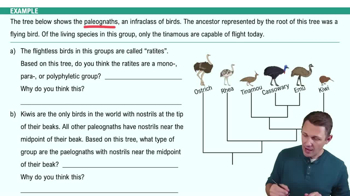To apply parsimony to constructing a phylogenetic tree, a. choose the tree that assumes all evolutionary changes are equally probable. b. choose the tree in which the branch points are based on as many shared derived characters as possible. c. choose the tree that represents the fewest evolutionary changes, in either DNA sequences or morphology. d. choose the tree with the fewest branch points.
VISUAL SKILLS Based on the tree below, which statement is not correct?
a.Goats and humans form a sister group. b. Salamanders are a sister group to the group containing lizards, goats, and humans. c. Salamanders are as closely related to goats as to humans. d. Lizards are more closely related to salamanders than to humans.
 Verified step by step guidance
Verified step by step guidance
Verified Solution
Key Concepts
Phylogenetic Trees

Sister Groups

Cladistics

VISUAL SKILLS In Figure 26.4, which similarly inclusive taxon is represented as descending from the same common ancestor as Canidae? a. Felidae b. Mustelidae c. Carnivora d. Lutra
Three living species X, Y, and Z share a common ancestor T, as do extinct species U and V. A grouping that consists of species T, X, Y, and Z (but not U or V) makes up a. a monophyletic taxon. b. an ingroup, with species U as the outgroup. c. a paraphyletic group. d. a polyphyletic group.
If you were using cladistics to build a phylogenetic tree of cats, which of the following would be the best outgroup? a. wolf b. domestic cat c. lion d. leopard
VISUAL SKILLS The relative lengths of the frog and mouse branches in the phylogenetic tree in Figure 26.13 indicate that a. frogs evolved before mice. b. mice evolved before frogs. c. the homolog has evolved more rapidly in mice. d. the homolog has evolved more slowly in mice.
